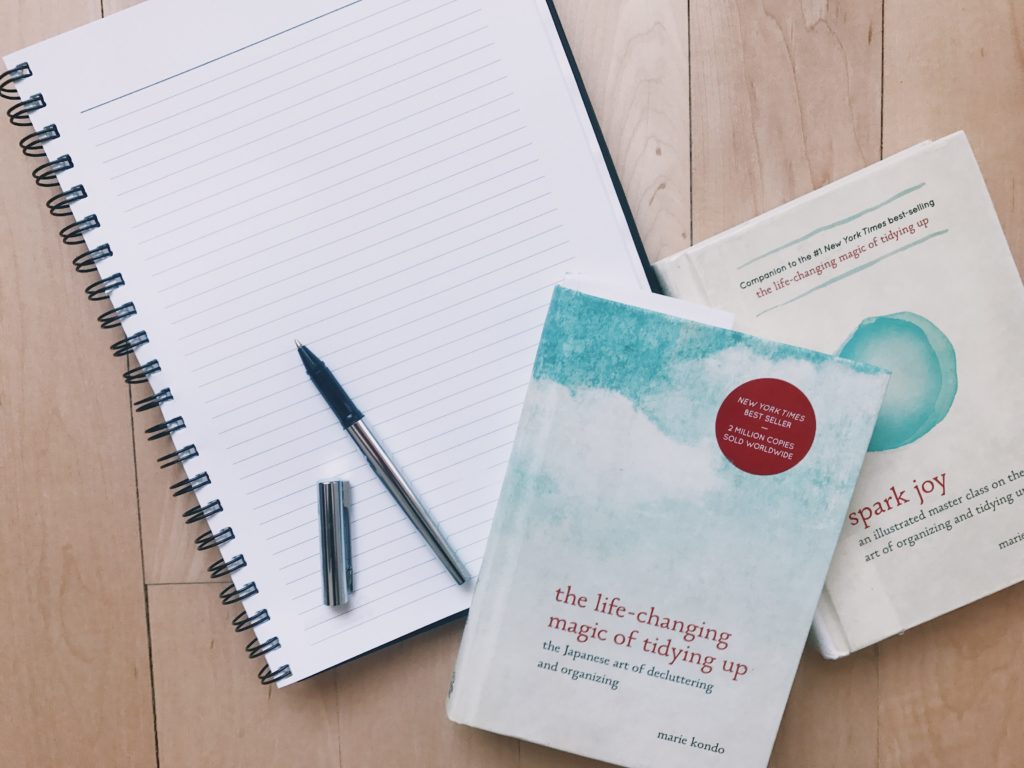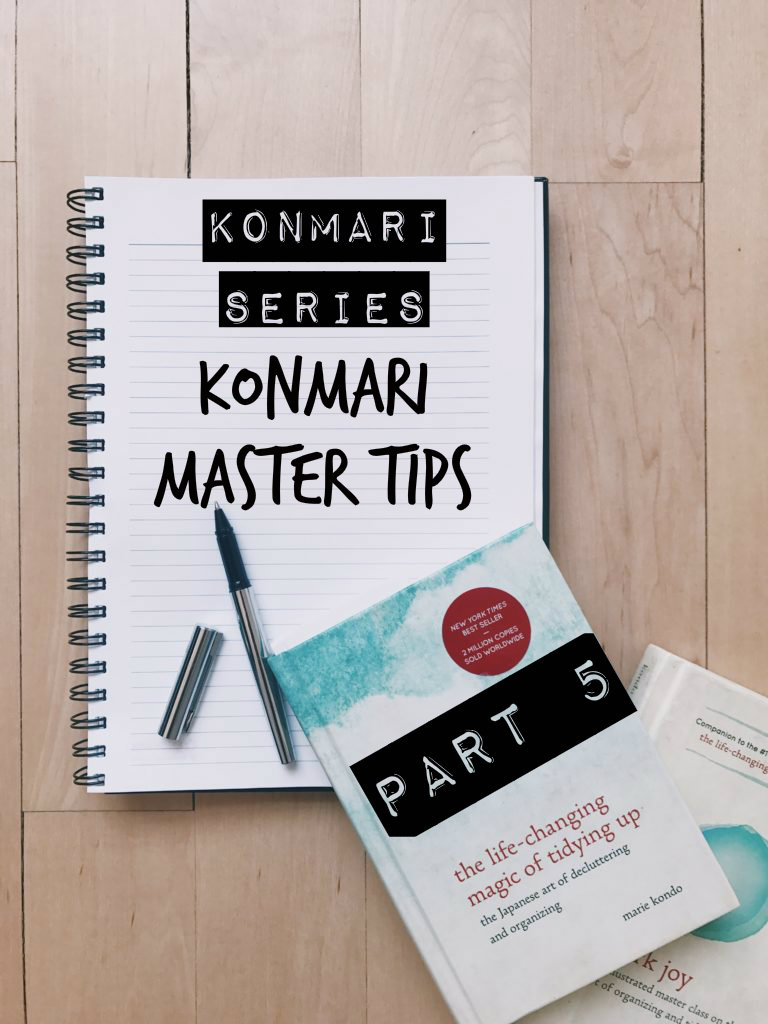This post is part of the KonMari Series in which I document my journey to becoming a certified KonMari organizing consultant. Start from the beginning here and/or see all posts of the series here.
Today, I share my notes of part of Marie Kondo’s second book “Spark Joy.” I’m dividing my writing about this book into two posts. In today’s (first) post, I am covering the KonMari master tips.
Please note that this should not serve as a complete summary of the book. However, it is merely a roundup of points that stood out to me and that I found important. I also add my personal reflections to some aspects.
Core Principles
In “Spark Joy”, Marie Kondo lays down the core principles of her tidying method again in a much more elaborated way. Questions you might have after reading “The Life-Changing Magic Of Tidying Up” are being answered in here. The best thing about the book is the second part in which she provides more detailed instructions on how to go about tidying the different categories and sub-categories, which I’ll cover next time in part 6. But today I’d like to start with the KonMari master tips.
Taking good care of your things leads to taking good care of yourself.
The six basic rules of tidying are the following:
- Commit yourself to tidying up.
- Imagine your ideal lifestyle.
- Finish discarding first.
- Tidy by category, not by location.
- Follow the right order.
- Ask yourself if it sparks joy.
These are rules Kondo wants you to keep in mind when you go through the tidying process. If you follow these general principles, everything else will fall in place.
Also, you should keep in mind that tidying and cleaning are two separate actions. Kondo states that if you don’t tidy your space first, you can never clean it completely and thoroughly. After all,
tidying is the act of confronting yourself; cleaning is the act of confronting nature.
How To Find Out What Sparks Joy
You should only keep the items that spark joy for you. But what if you can’t quite grasp that concept? What if you don’t really know what sparks joy for you and what does not? Kondo has a few suggestions on how to go about that and “hone your sensitivity to joy.”
First, you could start by comparing things. For instance, ask yourself what your three favorite items of clothing are and pick them out within three minutes. There you have it. These are items that bring you joy. You can now continue and see if other items elicit similar feelings for you. That should be your baseline. We’ll get to the things that don’t spark joy but you need/should keep regardless later.
Another suggestion Kondo brings forward is that you can start with clothing you’re wearing close to your heart, such as tops. She claims that we usually have more distinct/clearer feelings about those things. By starting with these, you can practice your joy muscle and get better as you progress.
A third option would be to hug the item in order to get really up close to it. Kondo also allows you to try on clothing if you’re unsure about it.
Keeping Items That Don’t Spark Joy
Kondo also addresses the concern many of you probably have: What should I do with things that don’t spark joy but I (might) need (e.g., winter underwear or tools)? Her answer to that is that you should discard it if it truly doesn’t spark joy for you. On the other hand, if you can’t bring yourself to let it go because you really need it, keep it! But keep it with confidence. So DON’T ban these items in a separate box or corner for the next couple of months – use them (until you may decide to get rid of them)!
Feelings of fascination, excitement, or attraction are not the only indications of joy. A simple design that puts you at ease, a high degree of functionality that makes life simpler, a sense of rightness, or the recognition that a possession is useful in our daily lives – these, too, indicate joy.
All in all, if you’ve come far enough in your tidying journey, it only makes you a more conscious buyer from now on. You’ll discover that you will only buy what you truly love going forward. That’s certainly true in my opinion. Since discovering that a minimalist lifestyle and owning only items that I like and use is ideal for me, I’ve started to implement this principle. When buying something new, I typically think hard about if I really want it and if I’m going to use it for a long(er) period of time.
There are three possible reasons why you can feel torn about an item:
- It once brought you joy, but has now fulfilled its purpose.
- It brings you joy, but you don’t realize it.
- You need to keep it, regardless whether or not it sparks joy (e.g., contracts, formal outfits, things – if discarded – could trigger anger from other family members).
You should treat all the items you keep as if they spark joy for you. Even the ones that don’t and you need to keep or those that you’re not quite sure about but decided to keep regardless. Kondo is convinced that you get to know ourselves better through that.
Filling Your Home With Joy
Before you start your tidying journey, Kondo recommends to visualize your ideal living space. You can simply flip through magazines and cut out pictures of interiors you like and that you’d like your own home to look like. It’s always good to have a goal or vision in mind. It makes it easier for you to follow through with the tidying process.
Also, after you’re done with discarding and storing your items, you can add things to your home that may enhance your joy factor. These can be things like flowers, new towels or linens. Add things that make you like living in your home even more if that’s what makes you feel good. Again, everyone is different. Some people may strive for a minimalist look and feel, others may like a more colorful home with decoration and accessories that spark joy.
Another thing Kondo suggests is to display the items that spark joy for you but you don’t have any particular use for. This could be a fancy dress that you love but can’t really wear in public or a collection of can openers. Get creative and array these things where you can see them every day. That way, they can add to your joy in a greater way as opposed to if they were buried in a box you never open. You might not want to display those items in your home where guests can see them though. In cases like that, Kondo recommends to find corners of your home that typically only you have access to. For example, you could adorn the walls of your closet with postcards that spark joy for you. Get creative!
Storage Fundamentals
While going through the “joy check” and discarding period, you should keep in mind that all storage is temporary in this phase. Only when you’ve completed it with all your categories can you start storing for good. In the meantime, just make sure to put the items you decided to keep in places where you can see them. Also, make sure to keep items of the same category together in one spot.
When storing items, you can follow the principle of storing items of the same category as well as same/similar material together. Store glass items with glass items, cloth(-like) items with cloth, etc. However, it’s ok if you can’t quite follow this principle all of the time. Kondo says that “if your intuition tells you that this might be the place, then for now at least, it is most certainly right.”
You should pack your drawers like a bento box. By that, Kondo means that you should keep them 90% full. By following this rule, you can be certain that your drawers are not stuffed and not too empty, preventing folded clothing items from coming undone. She also advices against using too many dividers.
In general, there are four principles of storage:
- Fold items (if possible).
- Stand it upright.
- Store it in one spot.
- Divide storage space into square compartments.
You’ve accomplished the KonMari folding method to 90% if you’re able to make a rectangle by folding the two edges toward the center of the garment. After that, you can fold the rectangle in half lengthwise. You might skip this step depending on the length of the item. The last step is to fold the item in half or in thirds.
Keep in mind that there are always exceptions to the rules. For example, items that don’t stand upright on its own – such as very thick cardigans/sweaters – can be laid down. Very thin and flimsy items might best be stored rolled.
Always use built-in storage space first and start with storing the large items first. After you’re done with storing you might even want to get rid of furniture that is/was solely being used for storing items. You might not have a need for it any longer! This is definitely something that I want to do more of and that I already started doing. First of all, I’ve been freeing up space by discarding items and by storing items in a space-saving way. Folding has freed up so much space in my closet, it’s incredible!
——————–
In the next part of the KonMari series I will highlight important points of the heart of “Spark Joy,” the Tidying Encyclopedia.


